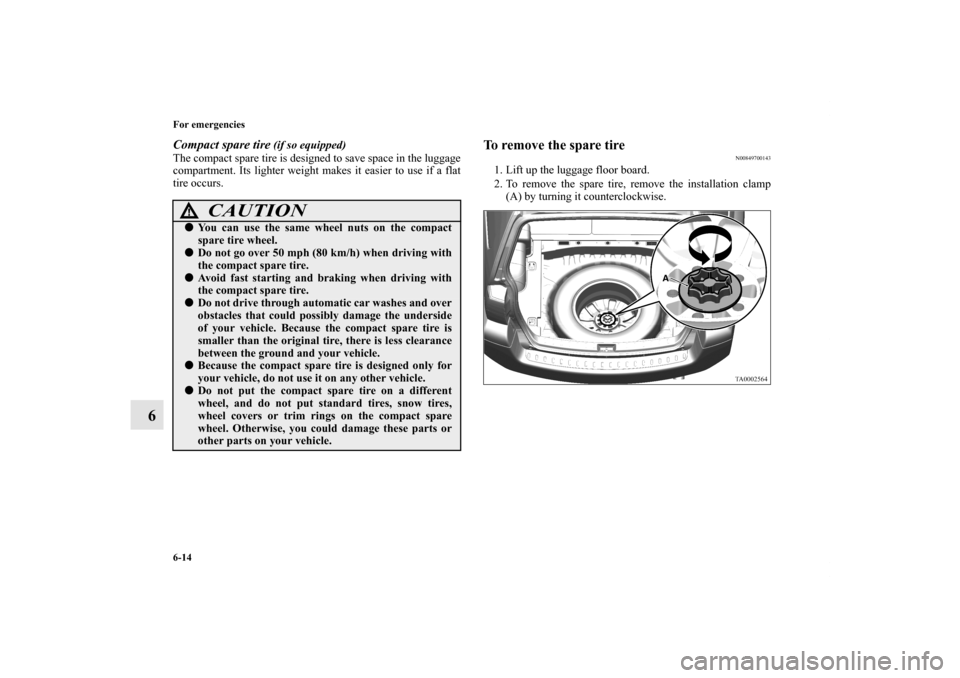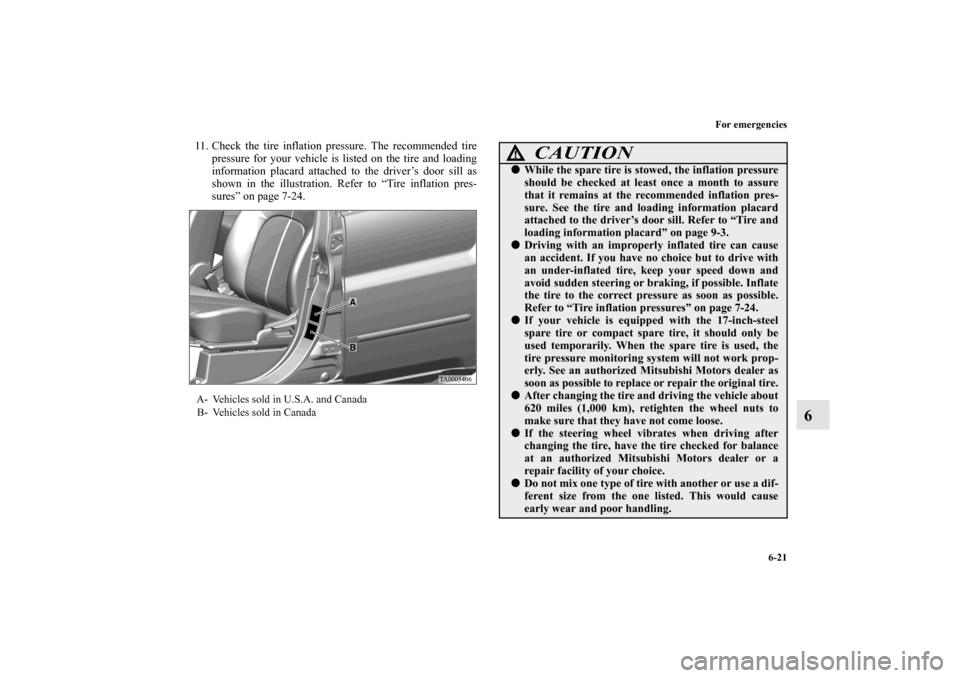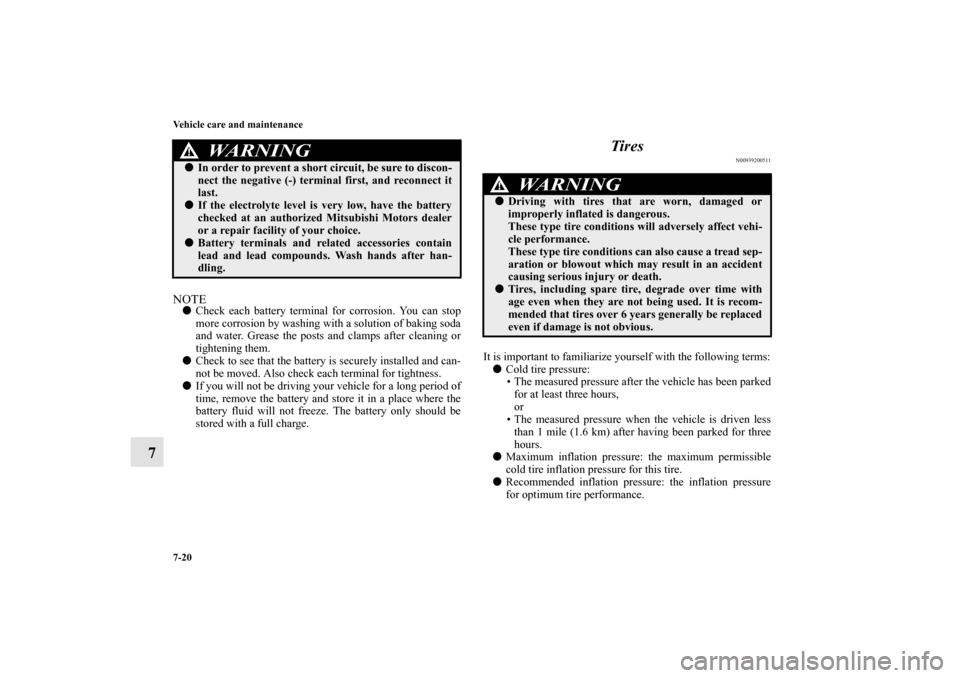Page 412 of 514

For emergencies
6-13
6
NOTE�The chocks shown in the illustration do not come with
your vehicle. It is recommended that you purchase chocks
or blocks and keep them in the vehicle for use if needed.
�If chocks or blocks are not available, use stones or any
other objects that are large enough to hold the wheel in
position.
6. Get the jack, bar and wheel nut wrench ready.
Refer to “Tools and jack” on page 6-7.Spare tire information
N00849600269
Check the air pressure of the spare tire frequently and make
sure it is ready for emergency use at any time.
Maintaining the spare tire at the air pressure listed on the tire
and loading information placard will ensure that it can always
be used under any conditions (city/high-speed driving, varying
load weight, etc.).
The spare tire is stored beneath the luggage floor board of the
luggage compartment.
WA R N I N G
!�Tires, including spare tire, degrade over time with
age even when they are not being used.
It is recommended that tires over 6 years generally
be replaced even if damage is not obvious.
CAUTION
!�While the spare tire is stowed, the inflation pressure
should be checked at least once a month to assure
that it remains at the recommended inflation pres-
sure. See the tire and loading information placard
attached to the driver’s door sill. Refer to “Tire and
loading information placard” on page 9-3.�Driving with an improperly inflated tire can cause
an accident. If you have no choice but to drive with
an under-inflated tire, keep your speed down and
avoid sudden steering or braking, if possible. Inflate
the tire to the correct pressure as soon as possible.
Refer to “Tire inflation pressures” on page 7-24.�If your vehicle is equipped with the 17-inch-steel
spare tire or compact spare tire, it should only be
used temporarily. When the spare tire is used, the
tire pressure monitoring system will not work prop-
erly. See an authorized Mitsubishi Motors dealer as
soon as possible to replace or repair the original tire.�You can use the same wheel nuts on the spare tire
wheel.
BK0102600US.book 13 ページ 2009年3月30日 月曜日 午後2時2分
Page 413 of 514

6-14 For emergencies
6
Compact spare tire
(if so equipped)
The compact spare tire is designed to save space in the luggage
compartment. Its lighter weight makes it easier to use if a flat
tire occurs.
To remove the spare tire
N00849700143
1. Lift up the luggage floor board.
2. To remove the spare tire, remove the installation clamp
(A) by turning it counterclockwise.
CAUTION
!�You can use the same wheel nuts on the compact
spare tire wheel.�Do not go over 50 mph (80 km/h) when driving with
the compact spare tire.�Avoid fast starting and braking when driving with
the compact spare tire. �Do not drive through automatic car washes and over
obstacles that could possibly damage the underside
of your vehicle. Because the compact spare tire is
smaller than the original tire, there is less clearance
between the ground and your vehicle. �Because the compact spare tire is designed only for
your vehicle, do not use it on any other vehicle. �Do not put the compact spare tire on a different
wheel, and do not put standard tires, snow tires,
wheel covers or trim rings on the compact spare
wheel. Otherwise, you could damage these parts or
other parts on your vehicle.
BK0102600US.book 14 ページ 2009年3月30日 月曜日 午後2時2分
Page 415 of 514
6-16 For emergencies
6
2. Place the jack under one of the jacking points (A) shown
in the illustration. Use the jacking point closest to the tire
you wish to change.3. Rotate the jack by hand until the flange portion (B) fits in
the groove (C) at the top of the jack.
WA R N I N G
!�Set the jack only at the positions shown here. If the
jack is set at a wrong position, it could dent your
vehicle or the jack might fall over and cause per-
sonal injury. �Do not use the jack on a tilted or soft surface.
Otherwise, the jack might slip and cause personal
injury. Always use the jack on a flat, hard surface.
Before setting the jack, make sure there are no sand
or pebbles under the jack base.
BK0102600US.book 16 ページ 2009年3月30日 月曜日 午後2時2分
Page 420 of 514

For emergencies
6-21
6
11. Check the tire inflation pressure. The recommended tire
pressure for your vehicle is listed on the tire and loading
information placard attached to the driver’s door sill as
shown in the illustration. Refer to “Tire inflation pres-
sures” on page 7-24.A- Vehicles sold in U.S.A. and Canada
B- Vehicles sold in Canada
CAUTION
!�While the spare tire is stowed, the inflation pressure
should be checked at least once a month to assure
that it remains at the recommended inflation pres-
sure. See the tire and loading information placard
attached to the driver’s door sill. Refer to “Tire and
loading information placard” on page 9-3.�Driving with an improperly inflated tire can cause
an accident. If you have no choice but to drive with
an under-inflated tire, keep your speed down and
avoid sudden steering or braking, if possible. Inflate
the tire to the correct pressure as soon as possible.
Refer to “Tire inflation pressures” on page 7-24.�If your vehicle is equipped with the 17-inch-steel
spare tire or compact spare tire, it should only be
used temporarily. When the spare tire is used, the
tire pressure monitoring system will not work prop-
erly. See an authorized Mitsubishi Motors dealer as
soon as possible to replace or repair the original tire.�After changing the tire and driving the vehicle about
620 miles (1,000 km), retighten the wheel nuts to
make sure that they have not come loose.�If the steering wheel vibrates when driving after
changing the tire, have the tire checked for balance
at an authorized Mitsubishi Motors dealer or a
repair facility of your choice.�Do not mix one type of tire with another or use a dif-
ferent size from the one listed. This would cause
early wear and poor handling.
BK0102600US.book 21 ページ 2009年3月30日 月曜日 午後2時2分
Page 421 of 514
6-22 For emergencies
6
To install the flat tire or spare tire
N00849900057
Tighten the clamp (A) firmly with your fingers by turning it
clockwise until the tire cannot move.
To store the jack, bar and wheel nut wrench
N00850000029
Reverse the removing procedure when storing the jack, bar and
wheel nut wrench.
Refer to “Tools and jack” on page 6-7.
BK0102600US.book 22 ページ 2009年3月30日 月曜日 午後2時2分
Page 425 of 514

6-26 For emergencies
6
On wet roads On snowy or icy roads
�When driving on a road covered with snow or ice, use
snow tires. Tire chains cannot be used on your vehicle.
There may be state or local regulations about using snow
tires. Always check the regulations in your local area
before using them. Refer to the section entitled “Snow
tires” on page 7-28 and “Tire chains” on page 7-29.
�Drive slowly. Do not make sudden starts or stops, sharp
turns, or slam on the brakes.
�Allow extra distance between your vehicle and the vehicle
in front of you, and avoid sudden braking.
�If a skid occurs when the accelerator pedal is depressed,
take your foot off the pedal. Steer gently in the direction
of the skid.
�Your vehicle is equipped with an anti-lock braking system
(ABS). Hold the brake pedal down firmly and keep it
depressed. Do not pump the brake pedal which will result
in reduced braking performance.
�After parking on snowy or icy road, it may be difficult to
move your vehicle due to freeze-up of the brake. Depress
the accelerator pedal little by little to move the vehicle
after confirming safety of the vehicle.
CAUTION
!�Avoid flooded roads. Water is often deeper than it
looks, and you could be seriously hurt by driving
into flood water. �When driving in rain, on water-covered roads, or
through a car wash, water could get into the brake
discs and make them fail temporarily. In such cases,
lightly press the brake pedal to see if they are work-
ing properly. If they are not, press the pedal lightly
several times while driving to dry the brake pads,
then check them again. �When driving in rain, a layer of water may form
between the tires and the road surface (aquaplan-
ing). This loosens your tires’ grip on the road, mak-
ing it difficult to steer or brake properly. When
driving on a wet road:
• Drive your vehicle at a safe speed.
• Do not drive on worn tires.
• Always keep the tires at the correct inflation pres-
sures.
CAUTION
!�Do not depress the accelerator pedal rapidly. The
vehicle could start moving when it breaks free from
the ice, possibly resulting in an accident.
BK0102600US.book 26 ページ 2009年3月30日 月曜日 午後2時2分
Page 426 of 514
For emergencies
6-27
6
On a bumpy or rutted road�Drive as slow as possible when driving on bumpy, rutted
roads or over potholes.
CAUTION
!�Driving on bumpy, rutted roads or over potholes can
damage the tires and wheels.
Wheels with low-profiles tires or under-inflated tires
are especially at risk for damage.
BK0102600US.book 27 ページ 2009年3月30日 月曜日 午後2時2分
Page 447 of 514

7-20 Vehicle care and maintenance
7
NOTE�Check each battery terminal for corrosion. You can stop
more corrosion by washing with a solution of baking soda
and water. Grease the posts and clamps after cleaning or
tightening them.
�Check to see that the battery is securely installed and can-
not be moved. Also check each terminal for tightness.
�If you will not be driving your vehicle for a long period of
time, remove the battery and store it in a place where the
battery fluid will not freeze. The battery only should be
stored with a full charge.
Tires
N00939200511
It is important to familiarize yourself with the following terms:
�Cold tire pressure:
• The measured pressure after the vehicle has been parked
for at least three hours,
or
• The measured pressure when the vehicle is driven less
than 1 mile (1.6 km) after having been parked for three
hours.
�Maximum inflation pressure: the maximum permissible
cold tire inflation pressure for this tire.
�Recommended inflation pressure: the inflation pressure
for optimum tire performance.
�In order to prevent a short circuit, be sure to discon-
nect the negative (-) terminal first, and reconnect it
last.�If the electrolyte level is very low, have the battery
checked at an authorized Mitsubishi Motors dealer
or a repair facility of your choice.�Battery terminals and related accessories contain
lead and lead compounds. Wash hands after han-
dling.
WA R N I N G
!
WA R N I N G
!�Driving with tires that are worn, damaged or
improperly inflated is dangerous.
These type tire conditions will adversely affect vehi-
cle performance.
These type tire conditions can also cause a tread sep-
aration or blowout which may result in an accident
causing serious injury or death.�Tires, including spare tire, degrade over time with
age even when they are not being used. It is recom-
mended that tires over 6 years generally be replaced
even if damage is not obvious.
BK0102600US.book 20 ページ 2009年3月30日 月曜日 午後2時2分